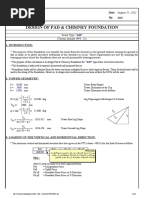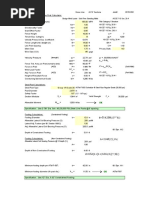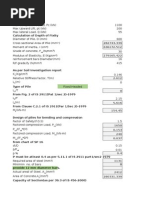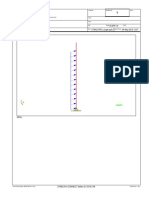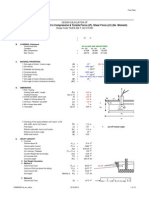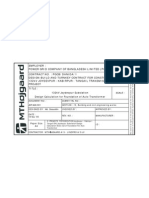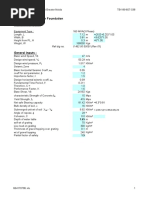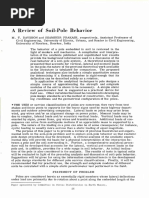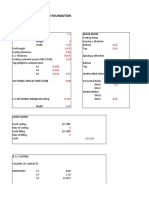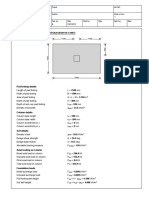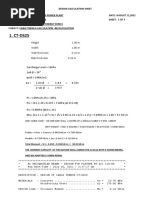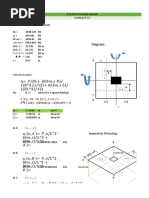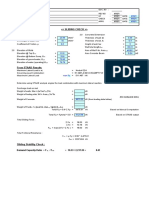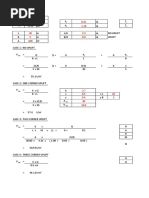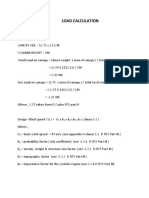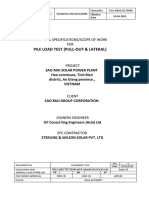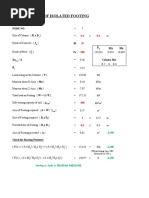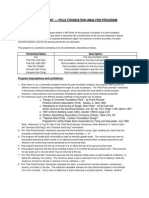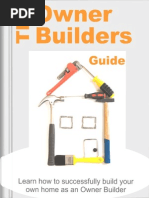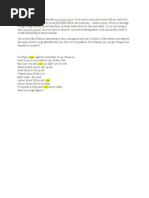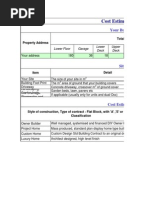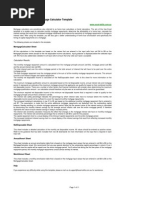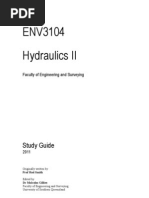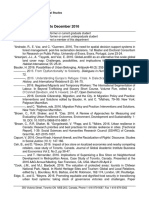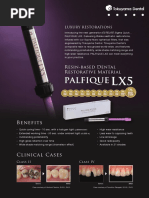Pier Footing
Pier Footing
Uploaded by
Mathurathipan RajendraseelanCopyright:
Available Formats
Pier Footing
Pier Footing
Uploaded by
Mathurathipan RajendraseelanOriginal Description:
Copyright
Available Formats
Share this document
Did you find this document useful?
Is this content inappropriate?
Copyright:
Available Formats
Pier Footing
Pier Footing
Uploaded by
Mathurathipan RajendraseelanCopyright:
Available Formats
ABC CONSULTING ENGINEERS
For Free-Top (Unconstrained) Rigid Round Piers Using PCA / Czerniak Method Subjected Vertical Load, Horizontal Load, and/or Moment Job Name : Subject : Pier Footing Design Job Number: Designer: RM Input Data: Pier Data: Pier Foundation Diameter, D = Pier Height Above Soil, h1 = Concrete Strength, f'c = Soil Data: Unit Weight of Soil, = Angle of Internal Friction, = Depth to Resisting Surface, h2 = Allow. Soil Bearing Pressure, Pa = Pier Loadings: Axial Load, Pv = Horizontal Load, Ph = Distance from Ph to Top/Pier, H = Externally Applied Moment, M = Results: 1.00 3.00 4.00 0.00
kN kN m kNm Pier Resisting Surface
Pv=1 kN
0.60 0.00 20.00
m m Mpa
M=0 kNm Ph=3 kN
20.00 30.00 0.00 100.00
kN/m3 deg. m kN/m2
H=4m h1=0m
Ground Line
h2=0m
L=2.06m
D=0.6m
Pier Embedment and Total Length: Nomenclature Ho = 5.00 kN/m Ho = Ph/D 20.00 kN-m/m Mo = (M+Ph*(H+h1+h2))/D Mo = E= 4.00 m E = Mo/Ho Kp = 3.00 Kp = TAN^2(45+/2) (passive soil pressure coefficient) R= 60.00 kN/m2/m R = Kp* (passive soil resistance/ft. depth) L= 2.06 m L = solution of cubic equation: L^3-(14*Ho/R)*L-(19*Mo/R)=0 L/D = 3.43 L/D <= 10 for valid short, rigid pier analysis L/D<=10, O.K. Lt = 2.06 m Lt = h1+h2+L (total length) Pier Side Soil Pressures: a= 1.42 m Pc = 42.47 kN/m2 Pc(allow) = 42.50 kN/m2 Pt = 111.75 kN/m2 Pt(allow) = 123.54 kN/m2 Pier End Bearing Pressure: m2 Af = 0.28 Wf = 0.09 kN Pv = 1.09 kN kN/m2 P(bot) = 3.85
a = L*(4*E/L+3)/(6*E/L+4) ("pivot" point from top of resisting surface) Pc = 1.18*(4*Mo+3*Ho*L)^2/(L^2*(3*Mo+2*Ho*L)) Pc(allow) = Pp*(a/2) Pc(allow)>=Pc, O.K. Pt = 9.42*(2*Mo+Ho*L)/L^2 Pt(allow) = Pp*L Pt(allow)>=Pt, O.K.
Af = *D^2/4 (pier base area) Wf = (Af*Lt)*0.150 (pier weight) Pv = Pv+Wf (total vertical load) P(bot) = Pv/Af
Pa>=P(bot), O.K.
(continued)
Pier Shear and Moment: Maximum Shear: V(max) = 12.29 kN Maximum Moment: M(max) = 12.09
(located at distance = a, from top of resisting surface) V(max) = ABS(Ho*D*(1-3*(4*E/L+3)*(a/L)^2+4*(3*E/L+2)*(a/L)^3) (located at distance = a/2, from top of resisting surface) M(max) = Ho*D*L*(E/L+a/2/L-(4*E/L+3)*(a/2/L)^3+(3*E/L+2)*(a/2/L)^4)
kNm
Pier Plain Concrete Stresses: Axial Compressive Stress: fa = 0.02 Mpa
fa = (Pv+*D^2/4*(h1+h2+a/2)*24)/(*(D)^2/4)/1000
Flexural Tension/Compression Stress: fb = 0.57 Mpa fb = M(max)/(*(D)^3/32)/1000 Combined Compression Stress: fc = 0.59 Mpa Fc(allow) = 12.00 Mpa Combined Tension Stress: ft = 0.55 Mpa Ft(allow) = 1.74 Mpa Shear Stress: fv = 0.04 Fv(allow) = 1.63 (AS 3600-2009 Clause 3.1.1.1 , = 0.6 - Table 2.2.2) fc = fb+fa (compression) Fc(allow) = *fc' Fc(allow)>=fc, O.K. (AS 3600-2009 Clause 3.1.1.3 , = 0.6 - Table 2.2.2) ft = fb-fa (tension) Ft(allow) = *0.36*(fc')0.5*1.8 Ft(allow)>=ft, O.K. (AS 3600-2009 Clause 8.2.7.1 , = 0.6 - Table 2.2.2) fv = V(max)/((*(D)^2/4)*1000) (shear) Fv(allow) = *(f'c)1/3 Fv(allow)>=fv, O.K.
Mpa Mpa
Applied Lateral Load and Resistance of Pole/Foundation Reference: "Resistance to Overturning of Single, Short Piles" - by Eli Czerniak ASCE Journal of the Struct. Div., Vol. 83, No. ST2, Paper 1188, Mar. 1957
Ph Embedment depth, L, is solution of: L^3-(14*Ho/R)*L-(19*Mo/R) = 0 E Resisting Surface Mo Ho a 2 a L Ground Line
R*L
Pc
Pt
V(max)
M(max)
Applied Load
Pole/Fdn. Rotation
Unit Resist. Available
Pressure Diagram
Shear Diagram
Moment Diagram
You might also like
- Design Pad & Chimney Foundation1Document26 pagesDesign Pad & Chimney Foundation1worldcentre100% (3)
- Design Fire WallDocument4 pagesDesign Fire WallAmarjit KulkarniNo ratings yet
- IDT FoundationDocument15 pagesIDT FoundationARUN RAWATNo ratings yet
- Fence CalculatorDocument2 pagesFence CalculatorIjaz MhNo ratings yet
- Design of Bored Piles Is 2911-Part 1sec2Document5 pagesDesign of Bored Piles Is 2911-Part 1sec2Armaan GuptaNo ratings yet
- Equipment Block Foundation DesignDocument1 pageEquipment Block Foundation DesigndantevariasNo ratings yet
- Karol Ghati Pile Calc 2Document2 pagesKarol Ghati Pile Calc 2Muhammad BilalNo ratings yet
- Pole FDNDocument24 pagesPole FDNyoussefNo ratings yet
- Design Pad & Chimney Foundation1Document25 pagesDesign Pad & Chimney Foundation1Umesh Chamara100% (10)
- Design of Rectangular Footing Col Edge 3Document28 pagesDesign of Rectangular Footing Col Edge 3Shaikh Muhammad AteeqNo ratings yet
- Design of Transformer Foundation PDFDocument3 pagesDesign of Transformer Foundation PDFJoyce ChepkiruiNo ratings yet
- FENCEDocument7 pagesFENCEARUN RAWATNo ratings yet
- STAAD - PRO - Single PoleDocument2 pagesSTAAD - PRO - Single PoleAmol GoleNo ratings yet
- Retaining Wall-Masonry Design and Calculation SpreadsheetDocument6 pagesRetaining Wall-Masonry Design and Calculation SpreadsheetfarrukhNo ratings yet
- Isolated Footing Design IS 456 2000Document12 pagesIsolated Footing Design IS 456 2000BalajiNo ratings yet
- Single Footing Design - Telecomm, Transmission & Guyed Tower & Pole - TIA 222F & ACIDocument12 pagesSingle Footing Design - Telecomm, Transmission & Guyed Tower & Pole - TIA 222F & ACIasad_naqvi100% (2)
- Transformer Foundation DesignDocument13 pagesTransformer Foundation DesignAUNGPSNo ratings yet
- Isolated Footing (ACI)Document4 pagesIsolated Footing (ACI)Boubakeur FerkousNo ratings yet
- Designs Design of Deck Slab (S1) : 1) Data: Overall Thickness 600 MMDocument11 pagesDesigns Design of Deck Slab (S1) : 1) Data: Overall Thickness 600 MMskumaraneeeNo ratings yet
- 160MVA TRFRFDNDocument23 pages160MVA TRFRFDNSohan Lal Jain100% (1)
- Anchor Bolt Design, IS Code LSDDocument33 pagesAnchor Bolt Design, IS Code LSDamlan jyoti ChakravortyNo ratings yet
- Pole Direct Embedment Into Soil 39-002 PDFDocument24 pagesPole Direct Embedment Into Soil 39-002 PDFsaroiitm100% (1)
- Embeded Depth of Pole Foundation Site Mozambique Method 1: Rule of Thumb MethodDocument4 pagesEmbeded Depth of Pole Foundation Site Mozambique Method 1: Rule of Thumb Methodvishnumani3011No ratings yet
- 10.14 Mva Transformer Foundation: Input Data Rebar Work Footing SizeDocument3 pages10.14 Mva Transformer Foundation: Input Data Rebar Work Footing SizeDesign explorer olomizana50% (2)
- Foundation Design For 66kV Steel Poles Bo-Kenema-SOIL CLASS 2A-08-11-21Document22 pagesFoundation Design For 66kV Steel Poles Bo-Kenema-SOIL CLASS 2A-08-11-21BAWA ALEXNo ratings yet
- M3D - SampleProblemSet ACI PDFDocument6 pagesM3D - SampleProblemSet ACI PDFasaisenthilNo ratings yet
- PT Foundation ApprovedDocument6 pagesPT Foundation ApprovedSujit RasailyNo ratings yet
- Security Tower Analysis ReportDocument30 pagesSecurity Tower Analysis ReportdovermanNo ratings yet
- Transformer Pile Calculations PDFDocument1 pageTransformer Pile Calculations PDFMaienAhasan100% (1)
- Transformator FoundationDocument109 pagesTransformator Foundationaswar_mh100% (3)
- IS875 (Part3) - Wind Loads On Buildings and Structures - IIT Kanpur-Part 1Document7 pagesIS875 (Part3) - Wind Loads On Buildings and Structures - IIT Kanpur-Part 1Adam Michael GreenNo ratings yet
- Pad Footing ExampleDocument6 pagesPad Footing ExampleYoussef AliNo ratings yet
- Design Calculation Sheet - Cable Trench RecalcsDocument4 pagesDesign Calculation Sheet - Cable Trench RecalcsAmol ChavanNo ratings yet
- Pit Side Wall and Base Slab CalculationDocument2 pagesPit Side Wall and Base Slab CalculationJahid HasnainNo ratings yet
- Pinned Base Plate (Rs Shear Key)Document7 pagesPinned Base Plate (Rs Shear Key)winlugue3059100% (2)
- Under Ground SumpDocument7 pagesUnder Ground SumpMariappan .PNo ratings yet
- As Per RCC Design (B.C. Punmia) Page 184 Example 7.6 Design of Cantilever ChajjaDocument32 pagesAs Per RCC Design (B.C. Punmia) Page 184 Example 7.6 Design of Cantilever ChajjajaffnaNo ratings yet
- Base Plate Design by Aisc-AsdDocument8 pagesBase Plate Design by Aisc-AsdPurnima Arkalgud100% (2)
- 1106.ductile Intermediate Beam Design As Per ACI 318MDocument4 pages1106.ductile Intermediate Beam Design As Per ACI 318MNapoleon CarinoNo ratings yet
- Footing Design According To BS8110 CodeDocument4 pagesFooting Design According To BS8110 CodeMohit VatsNo ratings yet
- Isolated Footing DesignDocument15 pagesIsolated Footing DesignAzzirrenNo ratings yet
- Light Pole Footing Design PDFDocument7 pagesLight Pole Footing Design PDFEmad Khan100% (1)
- Column Design and Calculation Frame ID (A1)Document8 pagesColumn Design and Calculation Frame ID (A1)Vikas MouryaNo ratings yet
- Grade Slab Design For Centeral Service Building PDFDocument14 pagesGrade Slab Design For Centeral Service Building PDFDavidQNo ratings yet
- Design of Compound WallDocument10 pagesDesign of Compound WallRam LangheNo ratings yet
- 2.0 Crack Width CheckDocument8 pages2.0 Crack Width CheckMoses LugtuNo ratings yet
- Sleeper Rev1Document23 pagesSleeper Rev1Yatendra TyagiNo ratings yet
- Tengs ChartDocument2 pagesTengs ChartV KARTHIK100% (1)
- Jhansi-Khajuraho Toll Plaza Load CalculationDocument3 pagesJhansi-Khajuraho Toll Plaza Load CalculationVarun Tyagi100% (1)
- Steel BeamDocument12 pagesSteel BeamV.m. RajanNo ratings yet
- "Anchor Reinforcement (Metric) ." - Anchor Reinforcement AnalysisDocument8 pages"Anchor Reinforcement (Metric) ." - Anchor Reinforcement AnalysisazwanNo ratings yet
- Calculation of Beam/Column Splice: HB-300x300x10x15Document5 pagesCalculation of Beam/Column Splice: HB-300x300x10x15mustika05No ratings yet
- Foundation Design of Lamp PostDocument1 pageFoundation Design of Lamp PostMayank Agrawal100% (1)
- Pile Load Test (Pull-Out & Lateral) : Technical Specifications/Scope of Work FORDocument15 pagesPile Load Test (Pull-Out & Lateral) : Technical Specifications/Scope of Work FORPriyanka GuleriaNo ratings yet
- Isolated Footing (4 Sides Wind)Document4 pagesIsolated Footing (4 Sides Wind)saiNo ratings yet
- Pole Foundation AnalysisDocument2 pagesPole Foundation AnalysisAhmed TahaNo ratings yet
- Polefdn - Pole Foundation Analysis ProgramDocument10 pagesPolefdn - Pole Foundation Analysis ProgramANGEL .No ratings yet
- POLEFDNDocument10 pagesPOLEFDNJulio Cesar AyalaNo ratings yet
- POLEFDNDocument10 pagesPOLEFDNcoolkaisyNo ratings yet
- Sampleclient New Residence Job No: 5001 Project Name:: #REF! #REF!Document1 pageSampleclient New Residence Job No: 5001 Project Name:: #REF! #REF!Mathurathipan RajendraseelanNo ratings yet
- Owner Builders Guide PreviewDocument13 pagesOwner Builders Guide PreviewMathurathipan RajendraseelanNo ratings yet
- Design Phase List Firms: List Firms:: Activity ZoningDocument9 pagesDesign Phase List Firms: List Firms:: Activity Zoningraha_yuNo ratings yet
- Owner Building ResearchDocument1 pageOwner Building ResearchMathurathipan RajendraseelanNo ratings yet
- Worksheet Cost Takeoff MF 04Document45 pagesWorksheet Cost Takeoff MF 04Mathurathipan RajendraseelanNo ratings yet
- Cost Breakdown SheetDocument4 pagesCost Breakdown SheetMathurathipan RajendraseelanNo ratings yet
- When Are Subcontractors Liable Under The Home Building Act1Document1 pageWhen Are Subcontractors Liable Under The Home Building Act1Mathurathipan RajendraseelanNo ratings yet
- Top 10 Tax Return Mistakes To AvoidDocument3 pagesTop 10 Tax Return Mistakes To AvoidMathurathipan RajendraseelanNo ratings yet
- Cost Estimate Spreadsheet: Your Building DetailsDocument67 pagesCost Estimate Spreadsheet: Your Building DetailsMathurathipan RajendraseelanNo ratings yet
- Owner Builders Guide PreviewDocument13 pagesOwner Builders Guide PreviewMathurathipan RajendraseelanNo ratings yet
- Start: Site AnalysisDocument1 pageStart: Site AnalysisMathurathipan RajendraseelanNo ratings yet
- Mortgage CalculatorDocument11 pagesMortgage CalculatorMathurathipan RajendraseelanNo ratings yet
- Cost Breakdown SheetDocument4 pagesCost Breakdown SheetMathurathipan RajendraseelanNo ratings yet
- Certificate IV in Civil Construction Design: Tafe NSW R I L CDocument5 pagesCertificate IV in Civil Construction Design: Tafe NSW R I L CMathurathipan RajendraseelanNo ratings yet
- Certificate IV in Civil Construction Design: Tafe NSW R I L CDocument4 pagesCertificate IV in Civil Construction Design: Tafe NSW R I L CMathurathipan RajendraseelanNo ratings yet
- Rule of Thumb Concrete DesignDocument54 pagesRule of Thumb Concrete DesignrunkirNo ratings yet
- Building Your New Home A Checklist May 2012 WebDocument20 pagesBuilding Your New Home A Checklist May 2012 WebMathurathipan Rajendraseelan100% (1)
- HydraulicsDocument190 pagesHydraulicsMathurathipan Rajendraseelan90% (10)
- Web Crushing & Yield Capacity CheckDocument1 pageWeb Crushing & Yield Capacity CheckMathurathipan RajendraseelanNo ratings yet
- Assignment 2 2012Document4 pagesAssignment 2 2012Mathurathipan RajendraseelanNo ratings yet
- World's First Water Treatment Techniques Using Apple and Tomato Peels - ScienceDailyDocument4 pagesWorld's First Water Treatment Techniques Using Apple and Tomato Peels - ScienceDailyorionNo ratings yet
- Balochistan Board of Intermediate and Secondary Education, QuettaDocument3 pagesBalochistan Board of Intermediate and Secondary Education, QuettaEngr Abdul KarimNo ratings yet
- Lesson 5 - Collective NounsDocument6 pagesLesson 5 - Collective NounsJoanne Nerissa NicolasNo ratings yet
- Homework Solution 10Document4 pagesHomework Solution 10Meli SeprinaNo ratings yet
- Semaphore Kingfisher Plus ManualDocument26 pagesSemaphore Kingfisher Plus ManualaudiocircuitNo ratings yet
- Ajax DPC-2803 PDFDocument304 pagesAjax DPC-2803 PDFPaul Villa100% (3)
- Cordillera: Cordillera Awe Inspiring Stairway To The SkiesDocument2 pagesCordillera: Cordillera Awe Inspiring Stairway To The SkiesMagdalena Depalog PadiosNo ratings yet
- Stepping Stones For Early ReadersDocument13 pagesStepping Stones For Early ReadersRica Mae Lingat BruanNo ratings yet
- Manual de Partes - Compactador VibratorioDocument582 pagesManual de Partes - Compactador VibratorioMichael Unzueta80% (5)
- Berita DLM BHS INGGRISDocument7 pagesBerita DLM BHS INGGRISKalberto ChandraNo ratings yet
- Training Programme: Central Soil and Materials Research StationDocument15 pagesTraining Programme: Central Soil and Materials Research StationRaviKumarNo ratings yet
- Saleh 2020Document6 pagesSaleh 2020Avijit ChaudhuriNo ratings yet
- Chitosan Hydrogel - Presentation of Discruptive Technology For Cosmetic MarketDocument15 pagesChitosan Hydrogel - Presentation of Discruptive Technology For Cosmetic MarketGrzegorz GorczycaNo ratings yet
- RyersonGeo Publications2016Document6 pagesRyersonGeo Publications2016Mamun Ar RashidNo ratings yet
- How To Draw Faces For Beginners - EhowDocument8 pagesHow To Draw Faces For Beginners - EhowSoc Rua NguyenNo ratings yet
- CD3 - Lect8 - تصميم جدار القص shear wallDocument100 pagesCD3 - Lect8 - تصميم جدار القص shear wallEnas MohamadNo ratings yet
- Fell's Fabulous Magical TransfomationsDocument26 pagesFell's Fabulous Magical TransfomationsGennaro RossiNo ratings yet
- Lab Report 1 - MillingDocument15 pagesLab Report 1 - MillingHOW MAN KIENNo ratings yet
- Buy Apple Watch Series 9 GPS + Cellular, 45mm Graphite Stainless Steel Case With Space Black Link Bracelet - AppleDocument1 pageBuy Apple Watch Series 9 GPS + Cellular, 45mm Graphite Stainless Steel Case With Space Black Link Bracelet - Applent6kyg8b64No ratings yet
- WeatheringDocument6 pagesWeatheringamit kumar guptaNo ratings yet
- Concrete Construction Article PDF - Mechanical vs. Lap SplicingDocument4 pagesConcrete Construction Article PDF - Mechanical vs. Lap SplicingGilven MedinaNo ratings yet
- IB DP Biology 1.1 Introduction To Cells QuestionDocument11 pagesIB DP Biology 1.1 Introduction To Cells QuestionikaNo ratings yet
- As 1289.6.4.2-1998 Methods of Testing Soils For Engineering Purposes Soil Strength and Consolidation TestsDocument2 pagesAs 1289.6.4.2-1998 Methods of Testing Soils For Engineering Purposes Soil Strength and Consolidation TestsSAI Global - APACNo ratings yet
- House ExtensionDocument2 pagesHouse ExtensionChristian HindangNo ratings yet
- Catalog PalfiqueDocument2 pagesCatalog PalfiqueAsyifa DentalNo ratings yet
- 07 Che 249 Distillation ColumnDocument8 pages07 Che 249 Distillation Column2024568653No ratings yet
- Sigma Plate Heat ExchangersDocument6 pagesSigma Plate Heat ExchangersDirkNo ratings yet
- Bio Engineering PresentationDocument6 pagesBio Engineering Presentationapi-346300743No ratings yet
- 20 J 9557 PDFDocument16 pages20 J 9557 PDFأنوار الحقNo ratings yet
- 4PW16741-1 B EKBT - Bufftertank - Installation Manuals - EnglishDocument6 pages4PW16741-1 B EKBT - Bufftertank - Installation Manuals - EnglishBernard GaterNo ratings yet
